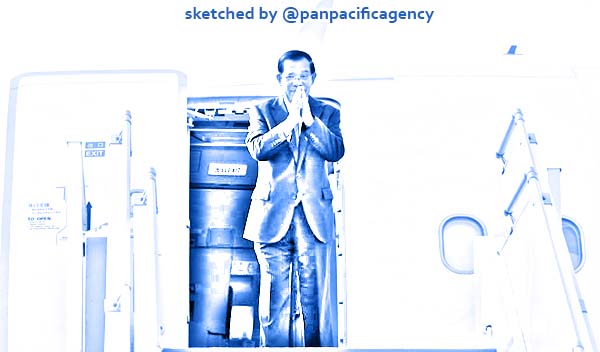[Analytics] What does the rise of semi-authoritarian regimes in Southeast Asia mean for the region?

Prime Minister Hun Sen departs for Europe. KT/Khem Sovannara. Sketched by the Pan Pacific Agency.
Southeast Asia has seen the rise of governments that cannot be easily categorized as either authoritarian or democratic. Exhibiting some characteristics of both, they are semi-authoritarian regimes, and in many countries in the region, authoritarian tendencies remain high despite notable democratic transitions. Umair Jamal specially for the ASEAN Today.
These regimes continue to go through various democratic processes, including elections and handovers of power from one party to another. However, while these processes do lead to changes, the role of the voter has never been central to such regimes; they have become “masters at stifling electoral competition or at keeping parliaments powerless and judiciary systems cowed,” according to Martha Brill Olcott and Marina Ottaway of the Carnegie Endowment for International Peace.
How do semi-authoritarian regimes operate in Southeast Asia?
Many factors explain why semi-authoritarian regimes in Southeast Asia are adopting democratic-looking political systems. For instance, the need for legitimacy in the eyes of their citizens forms the core of their efforts to rule without facing systematic challenges.
Pressure from the international community that ties the promotion of democracy to economic investments and aid packages also remains a driving force. Furthermore, at times, pressure from regional institutions and the democratization of neighboring states becomes a reason for such a shift.
By adopting formal traits of democracy and contesting elections, semi-authoritarian regimes protect themselves from what Olcott and Ottoway describe as “open competition that might threaten the tenure of the incumbents.”
These regimes are skilled at manipulating public opinion to maintain their hold on power by immersing the public’s stakes with their interests. “On the one hand, they [semi-authoritarian regimes] claim that that they are committed to popular empowerment and the redistribution of power; on the other, they emphasize that the risks of instability they claim are inherent in untrammeled competition and by so doing succeed in deflecting criticisms and reducing internal pressure for democratization,” wrote Olcott and Ottaway.
Do voters make a difference to semi-authoritarian regimes?
Governments and political parties across Southeast Asia have sought to gain power by promoting semi-authoritarian practices. At times, this involves the manipulation of institutions and holding elections. However, research suggests that voters have never been central to semi-authoritarian regimes.
There are several examples of this in Southeast Asia. For instance, in Indonesia, the current government is making alliances with local political parties in an attempt to control the outcome of local elections scheduled for later this year.
In Malaysia, Muhyiddin Yassin’s government was not directly elected by the voters. He became Prime Minister in March 2020 by sidelining the political party which won the 2018 general election. It looks as if he is using institutional powers to lay the ground for the expected forthcoming snap election.
In Myanmar, while political parties now run the government, the country’s military calls the shots from behind the scenes. Similarly, in Thailand, the military ruled the country with an iron fist for decades. However, the military now holds regular elections to create a façade of legitimacy and democracy.
According to scholar Johannes Gerschewski, Thai post-coup military governments rely on what he calls the “three pillars of stability: legitimation, repression and co-optation.” Or, as Eugénie Mérieau, in The Atlantic, explained: “Elites are co-opted, and pro-military civil-society groups, often members of the ‘bourgeois’ middle class, support what they see as coups for democracy whose effect is to maintain the traditional social structure in which they enjoy a favorable position.”
Essentially, the spread of semi-authoritarian regimes has frustrated pro-democracy supporters and curbed the competitiveness of elections. “Indeed, these regimes constitute the model type in Southeast Asia, having been introduced in Singapore during the late 1960s; in Malaysia, the Philippines and Indonesia during the 1970s; in Thailand during the early 1980s; in Burma, at least briefly in 1990 and in Cambodia shortly thereafter,” noted William Case in a paper titled Southeast Asia’s Hybrid Regimes: When Do Voters Change Them?
Does regionalization lead to democratization in semi-authoritarian regimes?
The case of ASEAN as a regional trading block shows that regionalism does not necessarily make much difference in terms of commitment to democratization and human rights. Although ASEAN was born due to the collaboration of pro-western and pro-market regimes, it has, over the years, evolved into a regional platform that promotes strong-arm politics.
For instance, last year, regional governments worked together to apply ASEAN’s principles to block a Cambodian opposition politician from returning home to confront Cambodian Prime Minister Hun Sen, the country’s long-serving authoritarian leader.
“Regarding the political activist from the neighboring country requesting to enter Thailand, I have proceeded by following the ASEAN resolution that we will not interfere with each other’s domestic affairs,” said Thailand’s Prime Minister Prayuth Chan-Ocha. “I have given the order. He won’t be able to enter,” he added.
“There seems to be a conspiracy within ASEAN to bend over backward to support an unpopular dictatorship in Cambodia,” said Malaysian legislator Charles Santiago, chairman of the ASEAN Parliamentarians for Human Rights group. “This is happening because some of the ASEAN countries have also denied a legitimate opposition from functioning in their own countries,” he added.
These regimes are so powerful that ASEAN cannot hold them accountable. In fact, they use ASEAN to protect themselves from accountability and undermine democratic voices. Thus, as long as authoritarian regimes endure in Southeast Asia, ASEAN’s ability to promote democratic practices will face challenges.